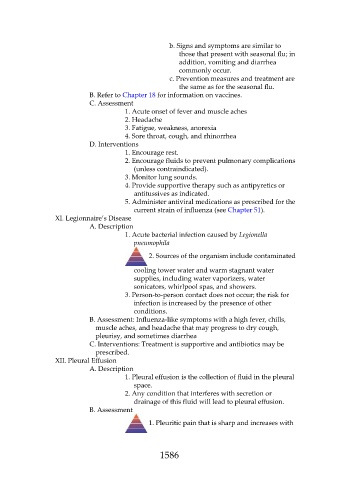Page 1586 - Saunders Comprehensive Review For NCLEX-RN
P. 1586
b. Signs and symptoms are similar to
those that present with seasonal flu; in
addition, vomiting and diarrhea
commonly occur.
c. Prevention measures and treatment are
the same as for the seasonal flu.
B. Refer to Chapter 18 for information on vaccines.
C. Assessment
1. Acute onset of fever and muscle aches
2. Headache
3. Fatigue, weakness, anorexia
4. Sore throat, cough, and rhinorrhea
D. Interventions
1. Encourage rest.
2. Encourage fluids to prevent pulmonary complications
(unless contraindicated).
3. Monitor lung sounds.
4. Provide supportive therapy such as antipyretics or
antitussives as indicated.
5. Administer antiviral medications as prescribed for the
current strain of influenza (see Chapter 51).
XI. Legionnaire’s Disease
A. Description
1. Acute bacterial infection caused by Legionella
pneumophila
2. Sources of the organism include contaminated
cooling tower water and warm stagnant water
supplies, including water vaporizers, water
sonicators, whirlpool spas, and showers.
3. Person-to-person contact does not occur; the risk for
infection is increased by the presence of other
conditions.
B. Assessment: Influenza-like symptoms with a high fever, chills,
muscle aches, and headache that may progress to dry cough,
pleurisy, and sometimes diarrhea
C. Interventions: Treatment is supportive and antibiotics may be
prescribed.
XII. Pleural Effusion
A. Description
1. Pleural effusion is the collection of fluid in the pleural
space.
2. Any condition that interferes with secretion or
drainage of this fluid will lead to pleural effusion.
B. Assessment
1. Pleuritic pain that is sharp and increases with
1586

